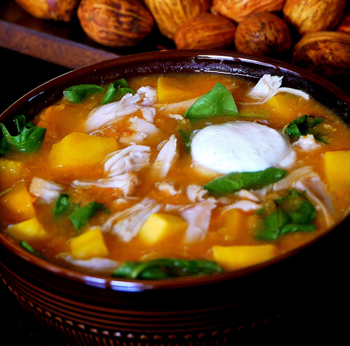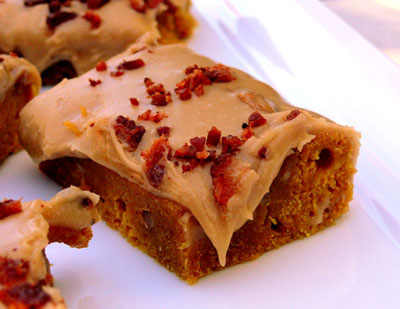 How to take pumpkin bars to the next level...add caramel frosting and bacon. This sure beats the regular cream cheese frosting we normally use with pumpkin desserts. The bacon adds a smoky, salty and crunchy complement, while the bacon drippings in the pumpkin layer add another subtle smoky taste.
How to take pumpkin bars to the next level...add caramel frosting and bacon. This sure beats the regular cream cheese frosting we normally use with pumpkin desserts. The bacon adds a smoky, salty and crunchy complement, while the bacon drippings in the pumpkin layer add another subtle smoky taste.
I have come to love bacon in my dessert. Itgives it that sweet-savory flavor I love. The caramel frosting is a take on Italian buttercream, however, themethod is actually easier and the results are "perfection".
Overall this is a great fall dessert. It would also go nicely as part of a Thanksgiving Day holiday dessert table.
Thank goodness these need to stay in the fridge, otherwise I would be grabbing one off the counter everytime I passed by.

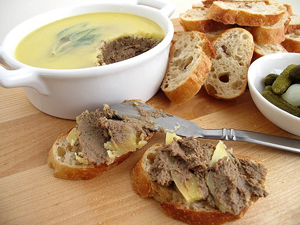 I love dining at bistros not just for the comforting French dishes, but also the appealing appetizers. Many times I've shared an appetizer of liver pâté with a friend over a bottle of wine and lots of bread. It's a very filling and not to mention budget-friendly meal. Different forms of pâté can be found throughout Europe, mainly in France, Scandinavia, and eastern Europe. In markets, pâté can be found sold in sausage-like tubes, which is commonly known as liverwurst here in the States. I grew up eating many different types of kenőmájas, as it is known in Hungarian. I couldn't imagine not eating it, especially around the holiday time. It makes a very nice appetizer with pickled vegetables and bread, crostini, or crackers.
I love dining at bistros not just for the comforting French dishes, but also the appealing appetizers. Many times I've shared an appetizer of liver pâté with a friend over a bottle of wine and lots of bread. It's a very filling and not to mention budget-friendly meal. Different forms of pâté can be found throughout Europe, mainly in France, Scandinavia, and eastern Europe. In markets, pâté can be found sold in sausage-like tubes, which is commonly known as liverwurst here in the States. I grew up eating many different types of kenőmájas, as it is known in Hungarian. I couldn't imagine not eating it, especially around the holiday time. It makes a very nice appetizer with pickled vegetables and bread, crostini, or crackers. The American media warns us at every turn that Christmas is a time of over-indulgence. Women’s magazines sprout articles about how to avoid the buffet table, not to mention an extra ten pounds. Readers flip quickly past that article to the one depicting how to decorate a sugar cookie.
The American media warns us at every turn that Christmas is a time of over-indulgence. Women’s magazines sprout articles about how to avoid the buffet table, not to mention an extra ten pounds. Readers flip quickly past that article to the one depicting how to decorate a sugar cookie.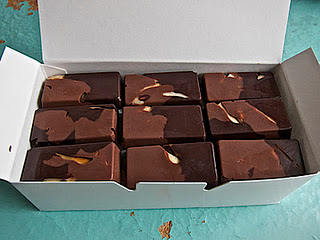 For the holidays I'm serving chocolate mini-candy bars at home and giving them as gifts. They're a lot of fun to make. They taste great and look so cool.
For the holidays I'm serving chocolate mini-candy bars at home and giving them as gifts. They're a lot of fun to make. They taste great and look so cool.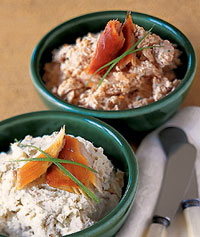 I always hated how it got so dark, so early in the winter. One day, a friend told me I just needed to manage until December 21st because that was the shortest day of the year and from
that day on it would get lighter a minute earlier each day. Growing up and working in Pittsburgh, anything that could help us through the cold and gloomy winter days was motivating, so I decided we needed to celebrate the day.
I always hated how it got so dark, so early in the winter. One day, a friend told me I just needed to manage until December 21st because that was the shortest day of the year and from
that day on it would get lighter a minute earlier each day. Growing up and working in Pittsburgh, anything that could help us through the cold and gloomy winter days was motivating, so I decided we needed to celebrate the day.
